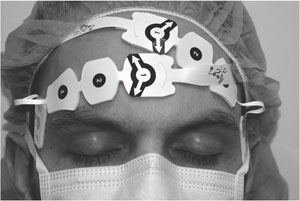
The bispectral index (BIS) monitor places a disposable sensor on a patient’s forehead that monitors brain activity.
Washington University Department of Anesthesiology
Anesthesiology researchers have shown that a device approved by the Food and Drug Administration to reduce the risk that patients will recall their surgery does not lower the risk of the problem, known as intraoperative awareness, any more than a less expensive method.
The new study, published Aug. 18 in The New England Journal of Medicine, involved more than 6,000 surgical patients at Washington University School of Medicine in St. Louis, the University of Chicago and the University of Manitoba in Winnipeg.
Unintended intraoperative awareness, also known as anesthesia awareness, occurs when a patient becomes aware during surgery and remembers being in pain or feeling distress during the operation. Between one in 500 and one in 1,000 surgery patients experience awareness during anesthesia. Those with such memories often need psychological help, and some even develop post-traumatic stress disorder.

Avidan
“We were testing whether a protocol based on a device called a bispectral index or BIS monitor, which measures brain activity to determine how deeply a patient is anesthetized, could more effectively prevent intraoperative awareness than an alternative approach that measures anesthetic levels in a patient’s breath,” says first author Michael S. Avidan, MB, BCh, professor of anesthesiology at Washington University School of Medicine. “This trial showed that the BIS measurement does not appear to be superior.”
The study focused on a subset of patients at high risk for awareness. They include patients undergoing cardiac surgery, those who regularly consume large amounts of alcohol or take sedatives or certain types of pain-killing drugs. Patients who previously have had episodes of awareness also are at high risk. The rate of intraoperative awareness in high-risk patients is estimated to be as high as 1 percent.
Called the international BIS or Anesthetic Gas to Reduce Explicit Recall (BAG-RECALL) trial, the multi-center study is the third involving the bispectral index in recent years. A 2004 study found that using BIS monitors could reduce awareness incidence by 82 percent.
Then in 2008, Avidan and his colleagues did a second study that followed almost 2,000 surgery patients at Barnes-Jewish Hospital in St. Louis. That study found that using a BIS monitor, which involves placing a disposable sensor on the patient’s forehead to monitor brain activity, was no better at preventing awareness than the less-expensive protocol based on the measurement of end-tidal anesthetic-agent concentration (ETAC), the concentration of anesthetic agents in patients’ exhaled breath.
Importantly, the trial found that both protocols were probably effective in decreasing the incidence of awareness, and the study did not rule out the possibility that the BIS protocol might confer a slight, but clinically meaningful, advantage.
The new study was designed to resolve whether the BIS protocol did, in fact, confer that clinically meaningful advantage. In the multi-center trial, investigators found that 19 of the 2,861 high-risk surgical patients in the BIS monitor group experienced either definite or possible intraoperative awareness. Among those randomized to the exhaled anesthetic technique, only eight of the 2,852 had intraoperative awareness.

“This study again found that both approaches were probably effective,” says co-investigator Alex S. Evers, MD, the Henry E. Mallinckrodt Professor and head of the Department of Anesthesiology at Washington University School of Medicine. “In many cases, the reason patients may experience awareness is because they do not receive an adequate concentration of anesthetic, so it makes sense to monitor the anesthetic drug levels closely. That’s one reason rigorously monitoring the concentration of drugs with the exhaled agent method appears to be so effective.”
Rather than keeping track of drug concentrations, BIS monitors use data from a single channel electroencephalogram (EEG) or brain-wave trace. When a person is fully awake, their BIS measurement approaches 100. No detectable brain activity would show up on the monitor as zero. The manufacturer recommends BIS readings should be between 40 and 60 during surgical anesthesia.
When guided by concentrations of anesthetic agents in a patient’s breath, doctors focus less on brain activity and instead monitor the actual concentration of anesthetics in the patient’s lungs.
“It is quite striking that for many years anesthesiologists have monitored the cardio-respiratory system very vigilantly, but we haven’t rigorously tried to monitor the nervous system, which is the site of action for anesthetic agents,” Avidan says. “That’s what the bispectral index attempted to do.”
Although neither technique prevented awareness in all patients, both methods seemed to work most of the time, even in the high-risk patients who were part of the study. Although intraoperative awareness was very rare, it did sometimes occur when monitoring techniques indicated patients should be unconscious.
“Our study does not show that the BIS monitor is ineffective,” Evers explains. “It’s just that it’s not superior to the protocol based on measuring the concentration of anesthetic a patient actually has received, which is a simpler and less expensive approach.”
Because the study showed that the structured approach to using BIS monitoring is no better than one based on measuring exhaled anesthetics, Avidan says the current, widespread use of the bispectral index in operating rooms should be re-examined.
“New technology has to prove its superiority over more cost-effective alternatives,” Avidan explains. “Our trial showed, compellingly, that the protocol based on the bispectral index is not superior.”
Avidan says other monitoring techniques based on EEG measurements may be useful in monitoring patients during surgery and might avoid a problem with the BIS monitor, which runs EEG readings through a proprietary algorithm that takes some time to process. There can be lags as long as a minute before a patient’s bispectral index reading changes in response to an arousal. He says faster processing of EEG values might be useful in producing a better real-time measurement of how deeply a patient is anesthetized.
For now, Avidan says closely monitoring the concentration of exhaled anesthetic agents and setting audible alerts for both high and low anesthetic concentrations appears to be at least as effective as the approach that was tested using BIS monitors to prevent intraoperative awareness in high-risk patients.
Avidan MS, et al, and the BAG-RECALL Research Group. Prevention of intraoperative awareness in a high-risk surgical population. The New England Journal of Medicine, vol. 365(7), Aug. 18, 2011.
This work was supported by grants from the Foundation for Anesthesia Education and Research, the American Society of Anesthesiologists and by a grant from the Winnipeg Regional Health Authority and the University of Manitoba Department of Anesthesia.
Washington University School of Medicine’s 2,100 employed and volunteer faculty physicians also are the medical staff of Barnes-Jewish and St. Louis Children’s hospitals. The School of Medicine is one of the leading medical research, teaching and patient care institutions in the nation, currently ranked fourth in the nation by U.S. News & World Report. Through its affiliations with Barnes-Jewish and St. Louis Children’s hospitals, the School of Medicine is linked to BJC HealthCare.